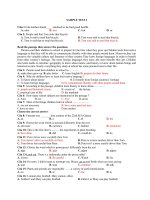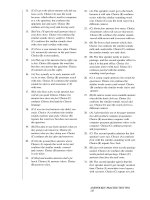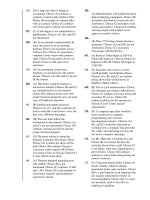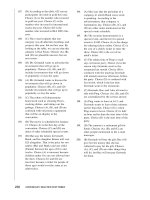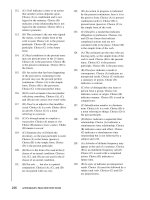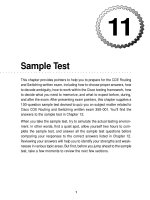Tài liệu SAMPLE TEST QUESTION FOR CSET: Vietnamese subtest II docx
Bạn đang xem bản rút gọn của tài liệu. Xem và tải ngay bản đầy đủ của tài liệu tại đây (564.35 KB, 20 trang )
California
Subject
Examinations fo
r
Teachers
®
CSET
®
®
TEST GUIDE
Copyright © 2004 by National Evaluation Systems, Inc. (NES®)
“California Subject Examinations for Teachers,” “CSET,” and the “CSET” logo are registered trademarks
of the California Commission on Teacher Credentialing and National Evaluation Systems, Inc. (NES®).
“NES®” and its logo are registered trademarks of National Evaluation Systems, Inc.™
VIETNAMESE
SUBTEST II
Sample Questions and Responses
and Scoring Information
CS-TG-QR170X-01
California Subject Examinations for Teachers Test Guide 1
Sample Test Questions for CSET: Vietnamese Subtest II
Below is a set of multiple-choice questions and constructed-response questions that are similar to the questions
you will see on Subtest II of CSET: Vietnamese. You are encouraged to respond to the questions without
looking at the responses provided in the next section. Record your responses on a sheet of paper and compare
them with the provided responses.
1. Which of the following contributions of
Nguyễn Du was most significant to the
development of Vietnamese literature?
A. his use of chữ Nôm and populari-
zation of literature for the general
public
B. his incorporation of modern
Chinese forms into Vietnamese
literature to generate a "social
realist" movement
C. his introducing the novel to
Vietnam, where poetry had been
the predominant literary genre
D. his institution of an academic
system for the study and dissem-
ination of literature
2. Read the poem below, "Qua đèo
Ngang" (1821) by Bà Huyện Thanh
Quan; then answer the question that
follows.
Bước tới đèo Ngang bóng xế tà.
Cỏ cây chen đá, lá chen hoa.
Lom-khom dưới núi tiều vài chú,
Lác-đác bên sông rợ mấy nhà.
Nhớ nước đau lòng con quốc-quốc
Thương nhà mỏi miệng cái gia-gia;
Dừng chân đứng lại: trời, non, nước.
Một mảnh tình riêng ta với ta.
The imagery in the above poem creates a
mood of:
A. disillusionment.
B. nostalgia.
C. confrontation.
D. fear.
Vietnamese Subtest II
2 California Subject Examinations for Teachers Test Guide
3. The vast majority of Vietnam's approxi-
mately 80 million people live on only
20 percent of the country's territory.
Which of the following best explains
this demographic pattern?
A. The rich agricultural land of the
large Red River delta region is the
traditional base of Vietnamese
civilization and remains the cultural
and economic center of the nation.
B. The geography and climate of the
smaller coast and river-delta
regions are much more hospitable
to economic development than the
inland plateaus and mountains.
C. Non-Viet ethnic groups have
traditionally controlled large inland
regions of the country and resisted
settlement by outsiders.
D. During the years of communist
rule, increasing numbers of people
have migrated to the south to take
advantage of the greater economic
opportunities available there.
4. Since the establishment of the Socialist
Republic of Vietnam, the two-generation
nuclear family of parents and children has
become increasingly more prevalent than
traditional multigeneration families in
Vietnam. This change has been most
influenced by:
A. official condemnation of Confucian
family values as foreign influences
on Vietnamese identity.
B. migration from rural to urban areas
and government policies to control
population growth.
C. official declarations that ancestor
worship is inconsistent with the
cultural values of a modern society.
D. the growing desire of women to
exchange domestic roles for careers
in business and the professions.
5. Traditional Vietnamese wood-block
prints frequently featured images of
flowers, fruits, animals, and scenes of
village work and activities. These images
were popular among villagers because
they:
A. constituted subject matter that was
familiar.
B. symbolized prosperity, fertility, and
longevity.
C. embodied the gods and spirits most
important to village life.
D. referred to ancient legends that
parents told their children.
Vietnamese Subtest II
California Subject Examinations for Teachers Test Guide 3
6. Use the information below to complete the exercise that follows.
The spirit of resistance is an attribute that is reflected to a high degree in the Vietnamese people and in
the literature of Vietnam.
Write a response, in either Vietnamese or English, in which you:
• identify a work of Vietnamese literature that reflects this spirit of resistance; and
• describe how the author of the work you have identified portrays that spirit.
Vietnamese Subtest II
4 California Subject Examinations for Teachers Test Guide
7. Read the poem below, "Vịnh vấn nguyệt" (late eighteenth century) by Hồ Xuân Hương; then
complete the exercise that follows.
Mấy vạn năm nay vẫn hãy còn
Cớ sao khi khuyết lại khi tròn
Hỏi con ngọc thỏ đà bao tuổi
Chứ chị Hằng Nga đã mấy con
Đêm vắng cớ sao quanh gác tía
Ngày thanh chút chẳng thẹn vầng son
Năm canh thơ thẩn chờ ai đó
Hay có tình riêng mấy nước non.
Using your knowledge of literature, write a response, in either Vietnamese or English, in which you:
• describe the mood of the poem; and
• give two examples of how the author uses literary devices to evoke that mood.
Vietnamese Subtest II
California Subject Examinations for Teachers Test Guide 5
8. Complete the exercise that follows.
Of Vietnam's diverse religions, Buddhism has long been one of the most significant.
Using your knowledge of Vietnamese history and culture, write a response, in either Vietnamese or
English, in which you:
• describe two reasons for Buddhism's appeal to the Vietnamese people; and
• analyze how Buddhism has guided and shaped Vietnamese thought and behavior.
Vietnamese Subtest II
6 California Subject Examinations for Teachers Test Guide
9. Complete the exercise that follows.
Located in the lower reaches of one of the world's mightiest rivers, the Mekong River delta has played
an increasingly significant role in Vietnamese history during the past three centuries.
Using your knowledge of Vietnamese geography and history, write a response, in either Vietnamese or
English, in which you describe the importance of the Mekong River delta (e.g., economic, social,
cultural) in historical and contemporary Vietnam.
California Subject Examinations for Teachers Test Guide 7
Sample Written Response Sheets for CSET:
Vietnamese Subtest II
For questions 6, 7, and 9, examinees would record their written response to each question on a one-page
response sheet located in their answer document. The length of their response to each question is limited to the
lined space available on the response sheet. A sample of the response sheet is provided below.
Vietnamese Subtest II
8 California Subject Examinations for Teachers Test Guide
For question 8, examinees would record their written response on a two-page response sheet located in their
answer document. The length of their response to this question is limited to the lined space available on the
response sheet. A sample of the response sheet is provided below and on the next page.
Vietnamese Subtest II
California Subject Examinations for Teachers Test Guide 9
10 California Subject Examinations for Teachers Test Guide
Annotated Responses to Sample Multiple-Choice Questions for CSET:
Vietnamese Subtest II
Literary and Cultural Texts and Traditions
1. Correct Response: A. (SMR Code: 3.1) Nguyễn Du was an East Asian classicist and knew Chinese
perfectly. When he wrote The Tale of Kieu, however, he used chữ Nôm rather than the Chinese
typically used by the Vietnamese scholars of his time. The Tale of Kieu was a long narrative poem
known as truyện Nôm (the tale in the southern script). Although based on a Chinese novel, it was
written in lục bát verse, a form accessible to the masses.
2. Correct Response: B. (SMR Code: 3.2) There are several images in this passage that create a mood
of nostalgia. In the poem, the sun is setting, the cuckoo wrings its heart in mourning, the partridge is
crying for home, and the author is between heaven and earth and is feeling alone.
Cultural Analysis and Comparisons
3. Correct Response: B. (SMR Code: 4.1) The most heavily populated regions of Vietnam are the
Mekong and Red river deltas, where the rich silt deposited by the two rivers has created soils that are
ideal for rice production. By contrast, the central coast, subject to destructive typhoons, as well as the
rugged, heavily forested mountains and plateaus that dominate large parts of the remainder of the
Vietnamese landscape, are much more sparsely populated.
4. Correct Response: B. (SMR Code: 4.2) With the creation of the Socialist Republic of Vietnam
(S.R.V.) in 1976, wartime migration from rural to urban areas continued unabated as the new
government established programs designed to promote industrial development. The S.R.V. also
instituted family planning policies in an effort to limit population growth. Both of these developments
undermined the traditional multigenerational family. Migration into the cities broke up extended
families in rural areas where they have long been most prevalent, while the birth control policies
fostered by the government encouraged citizens to adopt the two-child nuclear family as the ideal family
model.
5. Correct Response: B. (SMR Code: 4.3) Traditionally, the main function of Vietnamese wood-block
art was to produce prints of popular stories and themes that could be purchased and enjoyed by peasants
during major festivals. Images based on familiar rural settings that symbolized wishes for prosperity
(e.g., village scenes of buffalo herding and dancing), fertility (e.g., prints of the lotus), and longevity
(e.g., prints of the peach) were always great favorites.
California Subject Examinations for Teachers Test Guide 11
Examples of Responses to Sample Constructed-Response Questions for
CSET: Vietnamese Subtest II
Literary and Cultural Texts and Traditions
Question #6 (Strong Response)
Nam quốc sơn hà nam đế cư
Tiệt nhiên định phận tại thiên thư.
Như hà nghịch lỗ lai xâm phạm,
Nhữ đẳng hành khan thủ hại hư.
(Đất nước người Nam do vua nước Nam cai trị
Điều đó đã do ý Trời định.
Kẻ nghịch kia dám xâm phạm đất ta
Chỉ là mua lấy sự thất bại mà thôi.)
Bốn câu thơ bất hủ trên đây là của tướng Lý Thường Kiệt đặ
t ra và cho người lén vào đền
Trương-Hát bên sông thét vong lên làm phấn khởi tinh thần kháng chiến và quân Tống bị chặn
đứng không sao tiến được (1076).
Question #6 (Weak Response)
Ta thấy tinh thần chống Tây trong những tác phẩm của Nhất Linh. Trong một tác phẩm, tác giả
dùng hai nhân vật trẻ. Họ là con nhà quan làm việc cho Pháp. Nhưng những người trẻ này không
muốn tìm tiền bạc hay giàu sang bằng cách làm việc với Pháp. Họ đi biểu tình chống thực dân
Pháp. Người thì bị Tây bắt bỏ tù, người kia thì chết trong khi chạy trốn.
Vietnamese Subtest II
12 California Subject Examinations for Teachers Test Guide
Question #7 (Strong Response)
Trong bài thơ này, Hồ Xuân Hương có vẻ như trêu ghẹo Hằng Nga; bà như đùa cợt trên cái
cảnh lẻ loi của người đàn bà. Nhắc đến đêm vắng là nhắc đến tình trạng người đàn bà trong tình
trạng lẻ loi thiếu vắng người tình. Năm canh "thơ thẩn", suốt đêm đi tới đi lui chờ mong người tình
đến. Nhưng không thấy người tình chỉ thấy nước non thôi!
Để tạo nên cái thế gi
ới lẻ loi của Hằng Nga, tác giả dùng "đêm", phải, trăng thì chỉ lên buổi tối
thôi; nhưng đây là "đêm vắng", vắng bóng một người tình. Và để cho thấy là đêm vắng dài lắm, thi
sĩ dùng"năm canh" để chỉ "đêm dài" và Hằng Nga "thơ thẩn" là đi tản bộ để mong ngóng người tình
không đến.
Question #7 (Weak Response)
•Bài thơ này buồn vời vợi. Thi sĩ tả cảnh đêm tối không có ánh sáng mặt trời.
• Thi sĩ dùng màu tím buồn "gác tía" và nói đế "vầng son" tức là mặt trời
Vietnamese Subtest II
California Subject Examinations for Teachers Test Guide 13
Cultural Analysis and Comparisons (Extended-Response Question)
Question #8 (Strong Response)
Tinh túy của Phật giáo theo lời truyền dạy của Thích ca là thuyết tứ diệu đề. Bốn đại đề ấy là:
Khổ đề (đời là khổ), tập đề (nguồn gốc của sự khổ), diệt đề (phải diệt sự khổ), và đạo đề (phương
pháp diệt khổ). Người ta sống ở đời phải khổ vì sinh, bịnh, lão, tử. Nguồn gốc của sự khổ là v
ọng
tâm đã tạo nên sự luân hồi, nghiệp báo. Vậy phải diệt vọng tâm mới dứt được luân hồi, nghiệp báo.
Muốn thoát được luân hồi, phải noi theo con đường do đức Phật vạch ra. Đó là con đường tám
ngã hay còn gọi là "bát chánh đạo": Chánh kiến (ý kiến chánh), chánh tư duy (suy nghĩ chánh),
chánh ngữ (lời nói chánh), chánh nghiệp (việc làm chánh), chánh mạng (đời sống chánh), chánh
niệm (tâm niệm chánh), chánh định (thiền định chánh), chánh tinh tấn (tấn hóa chánh).
Có đi trọn con đườ
ng tám ngã ấy mới thành bậc hoàn toàn giác ngộ, mới thành Phật, và mới
nhập được niết bàn. Niết bàn chính là cái tâm giác ngộ của ta.
Đạo Phật được đa số người Việt Nam theo vì triết lý đạo Phật rất thích hợp với hoàn cảnh đau
khổ của một giống dân bị áp bức bởi ngoại xâm, bị giặc giả tàn phá. Thêm nữa đạo Phật dễ hòa
đồng với các đạo khác như đạo Khổng,
đạo Lão hay thuyết vạn vật hữu linh của người Việt.
Đạo Phật đã đi sâu vào tư tưởng cũng như nếp sống của người Việt Nam. Ý niệm gieo nhân
nào sẽ hái quả ấy của đại chúng đã từ triết lý nhân quả của đạo Phật mà ra. Những ý niệm về tiền
kiếp, hậu kiếp cũng từ quan niệm biệt nghiệp, công nghiệp của đạo Phật mà ra. Các ý niệm về từ
bi, hỉ xả, về nghiệp duyên, về tiểu hay đại ngã đều là những quan niệm triết lý của Phật giáo mà ta
thấy trong các tác phẩm văn chương nổi tiếng như Truyện Kiều. Tinh thần Từ bi của đạo Phật đã
tiềm ẩn cũng như hiển lộ trong văn chương truyền khẩu và văn chương bác học của người Việt
Nam.
Vietnamese Subtest II
14 California Subject Examinations for Teachers Test Guide
Question #8 (Weak Response)
Đạo Phật được nhiều người Việt Nam theo vì đạo này dạy người ta ăn ở hiền lành, ăn chay
niệm Phật, không cạnh tranh, tranh dành hay bám chặt vào của cải trần gian vì cuộc đời là ảo ảnh
có có không không.
Đạo Phật đã ảnh hưởng rất nhiều trên tư tưởng cũng như nếp sống của người Việt Nam. Phần
đông họ sống giản dị, ngày mồng một và ngày rằm thì họ
ăn chay, họ đặt bàn thờ Phật trong nhà và
gõ mõ tụng kinh, họ chấp nhận cuộc sống của họ, giàu hay nghèo họ không than trách mà cho là số
phận xếp sao chịu vậy. Những ngày lễ lớn họ đi chùa, thắp nhan niệm Phật.
Cultural Analysis and Comparisons (Short [Focused]-Response Question)
Question #9 (Strong Response)
Đồng bằng sông Cửu Long chiếm phần lớn đất miền nam Việt Nam. Trước kia nó do người
Khmer sở hữu. Đến thế kỷ 17, với cuộc Nam Tiến, người Việt đã chiếm lấy vùng này, người
Khmer phải lui về phần đất nằm về phía tây, ngày nay là Campuchia.
Một số người Khmer vẫn ở lại và sinh sống với người Việt. Sau này họ thành một nhóm thiểu
số gọi là Khmer Krom.
Đất phù sa của sông Cử
u Long làm cho đồng bằng rất phì nhiêu và dân Việt đã trồng lúa không
những để ăn mà còn để xuất cảng. Miền nam Việt Nam được coi là vựa lúa lớn nhất của Đông
nam Á.
Ngoài ra người dân Việt còn trồng nhiều mía, dừa và chuối.
Vì đất đai tốt, việc trồng trọt dễ dàng nên vùng đồng bằng sông Cửu Long rất đông dân cư.
Trong thời kỳ Pháp đô hộ, vùng này cũng là thành trì của các nhóm Hòa Hảo và Cao Đài.
Vi
ệt Nam đã cộng tác với Thái Lan và Lào để cải tiến việc tàu bè đi lại trên sông Cửu Long.
Trong những năm 1984–85 việc chuyên chở bằng tàu trên sông này đã gia tăng gấp đôi mức
chuyên chở năm 1976 giúp cho việc buôn bán bằng đuờng thủy phát đạt thêm.
Nhưng hiện nay Ðồng Bằng Sông Cửu Long đang bị nhiều vấn nạn như ô nhiễm môi sinh,
nhiễm mặn và ma túy ở lưu vực sông Cửu Long. Nếu không cứ
u nguy thì sẽ vĩnh viễn không còn
vựa lúa nuôi sống trăm triệu dân của nước và sẽ không còn văn minh miệt vườn nữa.
Vietnamese Subtest II
California Subject Examinations for Teachers Test Guide 15
Question #9 (Weak Response)
Đồng bằng sông Cửu Long ở miền nam Việt Nam. Sông Cửu Long chảy từ Tây Tạng xuống,
băng qua Lào và Campuchia. Đến Việt Nam sông chia ra nhiều nhánh và đỗ ra biển Nam Hải bằng
9 cái cửa nên gọi là "cửu long."
Dọc theo sông Cửu Long người ta sinh sống bằng nghề đánh cá, hai bên có nhiều kênh lạch, nên
thiên hạ đi lại bằng thuyền. Đất đai rất tốt nên họ trồng khoai lang, khoai mì, bắp, đậu nành và
nhiều lúa. Vùng này dân cư đông, người ta theo
đạo Hòa Hảo nhiều. Ít có người theo Công giáo.
16 California Subject Examinations for Teachers Test Guide
Scoring Information for CSET: Vietnamese Subtest II
Responses to the multiple-choice questions are scored electronically. Scores are based on the number of
questions answered correctly. There is no penalty for guessing.
Responses to constructed-response questions are scored by qualified California educators using focused holistic
scoring.
Because the constructed-response questions on CSET: Vietnamese Subtest II are of two types—one type
requiring a short (focused) response taking approximately 10–15 minutes to complete, and another type
requiring an extended response taking approximately 30–45 minutes to complete—two sets of performance
characteristics and two scoring scales will be used to score responses to the constructed-response questions.
Scorers will judge the overall effectiveness of your responses while focusing on the appropriate performance
characteristics that have been identified as important for this subtest (see below and pages 17–18). Each
response will be assigned a score based on an approved scoring scale (see pages 17 and 19).
Your performance on the subtest will be evaluated against a standard determined by the California Commission
on Teacher Credentialing based on professional judgments and recommendations of California educators.
Performance Characteristics and Scoring Scales for CSET: Vietnamese Subtest II
A. SHORT (FOCUSED)-RESPONSE QUESTIONS
Performance Characteristics. The following performance characteristics will guide the scoring of responses
to the short (focused)-response constructed-response questions on CSET: Vietnamese Subtest II.
PURPOSE
The extent to which the response addresses the constructed response assignment's
charge in relation to relevant CSET subject matter requirements.
SUBJECT MATTER
KNOWLEDGE
The application of accurate subject matter knowledge as described in the relevant
CSET subject matter requirements.
SUPPORT
The appropriateness and quality of the supporting evidence in relation to relevant
CSET subject matter requirements.
Relevant Subject Matter Requirements for Literary and Cultural Texts and Traditions
• Demonstrate an understanding of major movements, genres, writers, and works in the literature of the
target language.
• Demonstrate an understanding of the historical, social, and cultural influences on works of literature in
the target language.
• Use knowledge of the literary and cultural traditions of the target culture to interpret changes in that
culture over time.
• Demonstrate an understanding of the ways in which literary and intellectual works and movements of
cultures associated with the target language both reflected and shaped those cultures.
• Analyze and interpret a wide range of literary and cultural texts there is additional.
• Evaluate the use of language to convey meaning, to inform, to persuade, or to evoke reader response.
• Analyze the elements of literary works.
• Interpret the use of rhetorical and literary techniques.
Vietnamese Subtest II
California Subject Examinations for Teachers Test Guide 17
Relevant Subject Matter Requirements for Cultural Analysis and Comparisons
• Demonstrate an understanding of how all of the cultural perspectives within nations and cultures associated
with the target language interact to influence the development and evolution of the target cultures.
• Demonstrate familiarity with how the major physical and other geographical features of countries and
cultures associated with the target language have influenced the cultures' development and evolution.
• Analyze how political factors have influenced the development and evolution of cultures associated with the
target language, including the relationship between geography and political systems.
• Demonstrate familiarity with significant individuals, key eras, and major historical events and developments
within nations and cultures associated with the target language, and analyze their influence on the
development and evolution of the target cultures.
• Demonstrate an understanding of how the political, religious, social, economic, and educational systems and
institutions in nations and cultures associated with the target language have been shaped by and have
influenced the development and evolution of the target cultures.
• Demonstrate an understanding of how cultural practices exemplify cultural perspectives.
• Analyze cultural stereotypes and their effects on the perceptions of and attitudes toward the target cultures.
• Demonstrate an understanding of how the products of a target culture exemplify cultural perspectives.
Scoring Scale. Scores will be assigned to each response to the short (focused)-response constructed-response
questions on CSET: Vietnamese Subtest II according to the following scoring scale.
S
CORE
POINT
SCORE POINT DESCRIPTION
3
The "3" response reflects a command of the relevant knowledge and skills as defined in the
CSET subject matter requirements for Languages Other Than English.
• The purpose of the assignment is fully achieved.
• There is an accurate application of relevant subject matter knowledge.
• There is appropriate and specific relevant supporting evidence.
2
The "2" response reflects a general command of the relevant knowledge and skills as
defined in the CSET subject matter requirements for Languages Other Than English.
• The purpose of the assignment is largely achieved.
• There is a largely accurate application of relevant subject matter knowledge.
• There is acceptable relevant supporting evidence.
1
The "1" response reflects a limited or no command of the relevant knowledge and skills as
defined in the CSET subject matter requirements for Languages Other Than English.
• The purpose of the assignment is only partially or not achieved.
• There is limited or no application of relevant subject matter knowledge.
• There is little or no relevant supporting evidence.
U
The "U" (Unscorable) is assigned to a response that is unrelated to the assignment,
illegible, not in the target language or English, or does not contain a sufficient amount of
original work to score.
B
The "B" (Blank) is assigned to a response that is blank.
Vietnamese Subtest II
18 California Subject Examinations for Teachers Test Guide
B. EXTENDED-RESPONSE QUESTION
Performance Characteristics. The following performance characteristics will guide the scoring of responses
to the extended-response constructed-response question on CSET: Vietnamese Subtest II.
PURPOSE
The extent to which the response addresses the constructed-response
assignment's charge in relation to relevant CSET subject matter requirements.
SUBJECT MATTER
KNOWLEDGE
The application of accurate subject matter knowledge as described in the
relevant CSET subject matter requirements.
SUPPORT
The appropriateness and quality of the supporting evidence in relation to
relevant CSET subject matter requirements.
DEPTH AND BREADTH
OF UNDERSTANDING
The degree to which the response demonstrates understanding of the relevant
CSET subject matter requirements.
Relevant Subject Matter Requirements for Cultural Analysis and Comparisons
• Demonstrate an understanding of how all of the cultural perspectives within nations and cultures associated
with the target language interact to influence the development and evolution of the target cultures.
• Demonstrate familiarity with how the major physical and other geographical features of countries and
cultures associated with the target language have influenced the cultures' development and evolution.
• Analyze how political factors have influenced the development and evolution of cultures associated with the
target language, including the relationship between geography and political systems.
• Demonstrate familiarity with significant individuals, key eras, and major historical events and developments
within nations and cultures associated with the target language, and analyze their influence on the
development and evolution of the target cultures.
• Demonstrate an understanding of how the political, religious, social, economic, and educational systems and
institutions in nations and cultures associated with the target language have been shaped by and have
influenced the development and evolution of the target cultures.
• Demonstrate an understanding of how cultural practices exemplify cultural perspectives.
• Analyze cultural stereotypes and their effects on the perceptions of and attitudes toward the target cultures.
• Demonstrate an understanding of how the products of a target culture exemplify cultural perspectives.
Vietnamese Subtest II
California Subject Examinations for Teachers Test Guide 19
Scoring Scale. Scores will be assigned to each response to the extended-response constructed-response
question on CSET: Vietnamese Subtest II according to the following scoring scale.
S
CORE
POINT
SCORE POINT DESCRIPTION
4
The "4" response reflects a thorough command of the relevant knowledge and skills as
defined in the CSET subject matter requirements for Languages Other Than English.
• The purpose of the assignment is fully achieved.
• There is a substantial and accurate application of relevant subject matter knowledge.
• The supporting evidence is sound; there are high-quality, relevant examples.
• The response reflects a comprehensive understanding of the assignment.
3
The "3" response reflects a general command of the relevant knowledge and skills as defined
in the CSET subject matter requirements for Languages Other Than English.
• The purpose of the assignment is largely achieved.
• There is a largely accurate application of relevant subject matter knowledge.
• The supporting evidence is adequate; there are some acceptable, relevant examples.
• The response reflects an adequate understanding of the assignment.
2
The "2" response reflects a limited command of the relevant knowledge and skills as defined
in the CSET subject matter requirements for Languages Other Than English.
• The purpose of the assignment is partially achieved.
• There is limited accurate application of relevant subject matter knowledge.
• The supporting evidence is limited; there are few relevant examples.
• The response reflects a limited understanding of the assignment.
1
The "1" response reflects little or no command of the relevant knowledge and skills as
defined in the CSET subject matter requirements for Languages Other Than English.
• The purpose of the assignment is not achieved.
• There is little or no accurate application of relevant subject matter knowledge.
• The supporting evidence is weak; there are no or few relevant examples.
• The response reflects little or no understanding of the assignment.
U
The "U" (Unscorable) is assigned to a response that is unrelated to the assignment, illegible,
not in the target language or English, or does not contain a sufficient amount of original work
to score.
B
The "B" (Blank) is assigned to a response that is blank.
